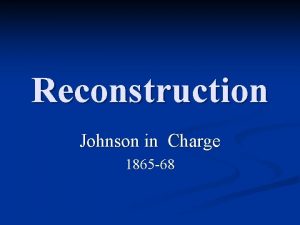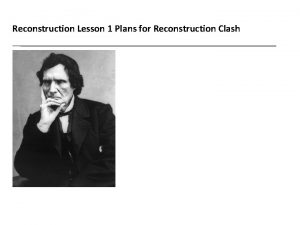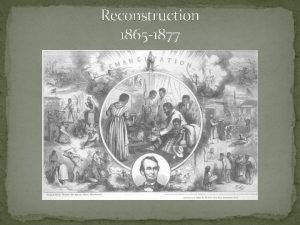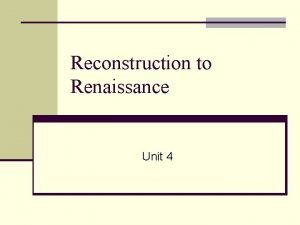Southern Reconstruction Southern Devastation Results were catastrophic for
















- Slides: 16

Southern Reconstruction

Southern Devastation • Results were catastrophic for southern economy. – Towns had been gutted of all resources, plantations burned, fields neglected, bridges and railroads had been destroyed. • 258, 000 men (20% of the southern male population) had been killed in the war. – Most of those who did return were badly disfigured. • Most wealthy southern whites had spent nearly all of their money supporting the Confederacy. – All Confederate bonds and currency were worthless and their property destroyed.

Romanticized Confederacy • Cult like mourning became common among southern people. – Extending traditional mourning periods of dressing black and grieving the dead for up to 2 years. • Confederate leaders like Robert E. Lee, Stonewall Jackson, and Jefferson Davis were lifted to positions of revere, nearly like religious figures. • Monuments and shrines were erected throughout southern towns in honor of those who had died for the “Lost Cause”.

Emergence of Radical Republicans • Many Republicans feared that new southern leaders would re-unite the forces of the Democrat party once back in the Union. – New resistance from the party could undo many of the legislative measures taken by them during the war. – They feared too lenient of a policy would allow southern states to resemble the more powerful north. • Radical Republicans: led by Thaddeus Stevens and Charles Sumner – Significant group that wanted to punish the south for the anguish caused during the war.

Andrew Johnson • A former Democrat from Tennessee – Only became a Republican when he joined the Lincoln ticket in 1864. – Not very well liked, prone to anger, and rumored to have been a drinker. – Wasn’t trusted by the Radica Republicans. • Lincoln had been the only politician willing, but also popular enough, to save the south from punishment.

Johnson’s Plan • Johnson pushed through his plan for Reconstruction during the summer of 1865 – Many Radical Republicans were in their home states on recess. • Johnson’s plan for Reconstruction of the South – Grant amnesty to all Confederate soldiers – High Ranking officers and landholders worth more than $20, 000 had to personally apply to the President for their citizenship. – Required a majority of citizens to vote for readmission. – Until they did so he could appoint provisional governors

Johnson’s Plan Cont. • The final step for each Confederate state to return to the Union: – They hade to revoke their ordinances of secession – Abolish slavery and accept the 13 th Amendment – Repudiate all war debts (refuse them) • Unfortunately, many of the new states that accepted Johnson’s terms elected former Confederate officials to new government positions – This angered the Radicals when they returned in the fall • During the midterm elections of 1866 the Radicals received a 2/3 majority in Congress which allowed them to override any act made by Johnson.

Congressional Radical Reconstruction • With Lincoln gone and Johnson weak the Radical republicans placed their own reconstruction plan • 1. disenfranchised Confederate soldiers so that they were not allowed to vote or hold office in newly appointed southern governments. • 2. the Reconstruction Act placed all southern states under military rule. • 3. Southern states had to accept the 14 th Amendment granting all slaves citizenship.

Radicals Cont. • Radicals also passed Civil Rights Acts that guaranteed black citizenship and allowed Congress to intervene in state issues. – When Johnson vetoed the acts they simply overrode him. • Black Codes – Laws created in many southern states to try and revoke rights of many newly freed slaves. – Example: make people provide family history to obtain marriage license. • To combat these types of laws the Radicals passed the 15 th Amendment. – Granted full suffrage and rights to all citizens regardless of their previous conditions or servitude.

Congressional Acts • To prohibit Johnson from interfering with their plans, the Radicals passed two very questionable Acts. • Tenure of Office Act: prohibited the President from removing any executive officials without consent of the Senate. – They did this to protect member of Lincoln’s old cabinet that Johnson struggled with. (Edwin Stanton) • Command of the Army Act: prohibited the President from assigning orders to the military except through commanding generals. – The generals couldn’t be relieved or reassigned without consent of the Senate.

Johnson Impeached • Even though Radicals had free reign to pass legislation they deemed fit, they still needed Johnson to enforce their laws. – They began seeking a way to remove him from office. • When Johnson dismissed Edwin Stanton, Sec. of War, without Senatorial consent he violated the Tenure of Office Act. • Johnson became the first President in U. S. history to be impeached. – He was found guilty by a vote of 35 to 19, just one vote short of removal from office.

Life in the South • The Freedmen’s Bureau – Developed shortly after the war, the agency’s primary objective was to aide former slaves and refugees of the war. – They provided food to millions of poor slaves – Established schools, missionaries, and churches throughout southern territories. – Only had authority to help for roughly one year • Most freedmen had nowhere to go once the war was over – Many former slaves were found roaming the countryside looking for a place to settle. – Often they stayed close to the occupying armies of each state hoping for handouts.

Reconstruction Governments • Carpet Bag Governments – Since confederate soldiers couldn’t vote, many northern businessmen moved south and convinced former slaves to vote for them in elections. – Many southern states responded with literacy tests attempting to prohibit black people from voting. – 15 th Amendment: granted the right to vote to all citizens regardless of race. You DON’T have to take a test to vote. • Scalawags – Term of disdain for southern voters who supported these new governments. – Most were former Whigs who turned to Republicans after the war.

The Sharecropping System • Plantation owners needed to make money from their land without the use of slaves. – Most of them had lost any wealth they had to begin with when the Confederacy lost, and their plantations were virtually destroyed. • Share Cropping System: poor farmers in the south worked the land for wealthy landlords using their own equipment and sharing the profits. – Many sharecroppers were uneducated and usually taken advantage of by landlords. – They could be removed from land at any time.

Southern States Redeemed • Southern white men found new ways to impart change in many states where Reconstruction acts had impacted the most. • The Ku Klux Klan: – The clan was initially formed by former Confederates who wanted to fight back against Reconstruction laws. – The used fear as their main tool • Lynching, beating, murders, and threats – They didn’t JUST target slaves, but also Carpet Baggers, Freedmen’s Bureau Officials, Scalawags – Their intent was to restore southern planter aristocracy and Democratic Party to power in the South.

Jim Crowe • When Reconstruction Acts were lifted and federal troops withdrew from the southern states many of the Civil Rights Acts lost their influence. • Segregation: the separation of people based strictly on race. – Jim Crowe laws were put in place throughout the south to separate black and white people – These laws remained in place until the 1960’s. • Plessy v. Ferguson (1896): case in Louisiana regarding segregation. Courts first ruled that separate was legal as long as they were equal.
 Catastrophic epilepsy infancy
Catastrophic epilepsy infancy Catastrophic risk protection endorsement
Catastrophic risk protection endorsement What are facilitative emotions
What are facilitative emotions Catastrophic event
Catastrophic event What are some types of catastrophic events
What are some types of catastrophic events What were the immediate effects of reconstruction
What were the immediate effects of reconstruction How did the holocaust develop and what were its results
How did the holocaust develop and what were its results Middle ages regents questions
Middle ages regents questions Ledarskapsteorier
Ledarskapsteorier Svenskt ramverk för digital samverkan
Svenskt ramverk för digital samverkan Datorkunskap för nybörjare
Datorkunskap för nybörjare Fredsgudinna
Fredsgudinna Rita perspektiv
Rita perspektiv Ministerstyre för och nackdelar
Ministerstyre för och nackdelar Plats för toran ark
Plats för toran ark Nationell inriktning för artificiell intelligens
Nationell inriktning för artificiell intelligens Bästa kameran för astrofoto
Bästa kameran för astrofoto






























